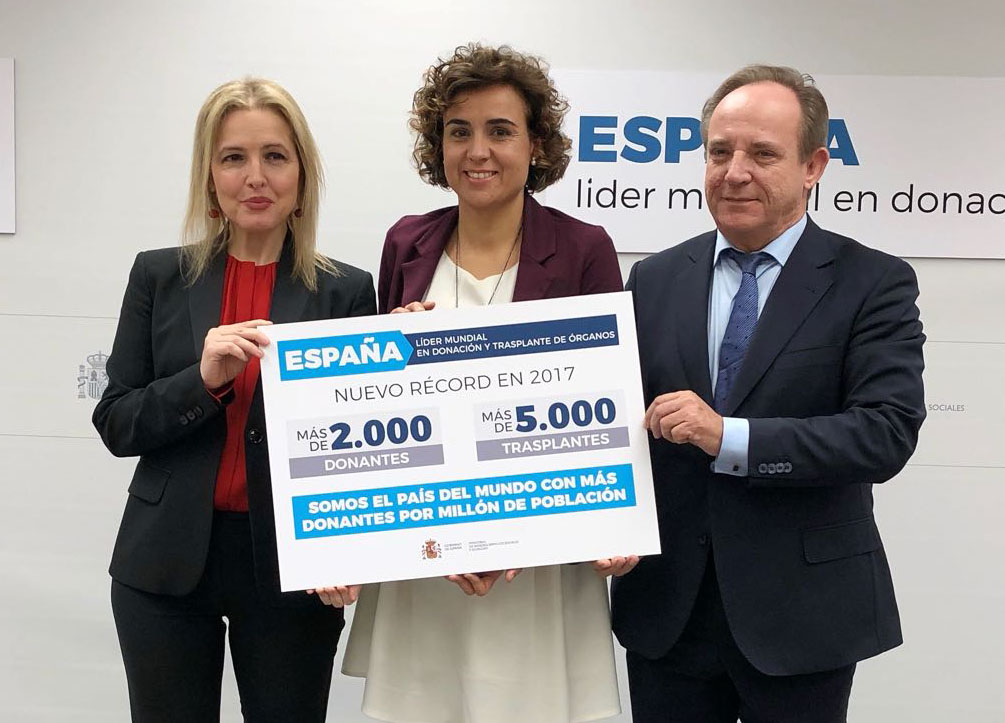Spain continues to break records and is once again the global leader in organ donation and transplantation”, says Dolors Montserrat, the Spanish Minister for Health
The country has maintained its global leadership for 26 straight years after it broke its own record by reaching 46.9 donors per million population in 2017, a total of 2,183 donors.
This led to 5,259 organ transplants, surpassing the figure of 5,000 for the first time in 2017. This result raises the transplant rate to 113 per million population and consolidates Spain internationally as ‘the transplant nation’.
Dolors Montserrat said that these are “the best figures in the history of the Spanish transplant system” and demonstrate that “Spain is the most generous country in the world, where more people donate organs that save lives”.
She added that the organ donor rate per million population has increased by 30% in the last three years. These figures show that six people a day donated their organs in 2017 and 14 transplants were performed daily.
“Professionalism and human generosity can be found behind each transplant. The best healthcare professionals and the most generous people come together on the same country project, a Spanish project, of which we should be proud”, she added.
Montserrat thanked everyone involved in the process and who make “our healthcare system one of the best in the world, demonstrating with each transplant that our great National Health System guarantees quality, universality, fairness, cohesion and equality for all Spaniards in the face of illness.
We are all equal in Spain, we receive an organ wherever we are from, because giving life knows no regional boundaries.
She also stressed that the Spanish transplant system is an international benchmark that has served as a model for countries around the world.
The minister made her comments at a press briefing where she was accompanied by the Secretary-General for Health, Javier Castrodeza, and the Director General of the Spanish National Transplant Organisation, Beatriz Domínguez-Gil.
The Director General, Beatriz Domínguez-Gil, explained the organ donation and transplantation activity data recorded in Spain during 2017. According to figures, Spain set new all-time records in both the total number of donors (up 8.1% to 2,183) and the number of solid organ transplants (up 9.1% to 5,261). New all-time records for the Spanish National Transplant Organisation were also recorded for kidney, liver and lung transplants, and increases were recorded in all types of transplant except pancreas.
In total, 3,269 kidney transplants (up 9%), 1,247 liver transplants (up 8%), 304 heart transplants (up 8%), 363 lung transplants (up 18%), 70 pancreas transplants (down 4%) and eight intestine transplants (up 100%) were performed. The waiting list has also shortened for all organs (except pancreas) from a total of 5,480 at the end of 2016 to 4,896 patients at 31 December 2017. Of those, 74 are children.
The involvement of ER doctors and intensive care specialists, as well as their close collaboration with transplant coordinators, is another of the keys to explaining the spectacular increase in the number of donors.
However, the number of live-donor kidney transplants continued to fall, with a total of 332 (compared with 341 in 2016). This is likely due to a greater chance of receiving a transplant from a deceased donor. This type of transplant accounts for 10.2% of the total.
Donors from road traffic accidents account for 4.2% of the total, the lowest percentage to date.
Furthermore, the gradual aging of donors is becoming more evident: over half (54.6%) are over 60; 30% are over 70; and 9% are over 80. The oldest age for an effective donor stands at 91 for a liver transplant.
Refusal from relatives stands at 12.9% (the lowest ever), which falls to 6.5% in the case of non heart-beating donors.
One out of five organs is transplanted in a region other than where the donor comes from.
All autonomous regions posted a rate in excess of 35 donors per million population, nine surpassed the national average (46.9) and, of those, four posted rates in excess of 70 donors per million population (the regions along the Cantabrian coast).
Cantabria tops the table with a rate of 74.1 donors per million population. This is followed by La Rioja (71), the Basque Country (70.3), Navarre (70.3) and Murcia (66).
In terms of absolute increases, the Region of Valencia stands out with a contribution of close on 30% to the overall increase in donors throughout Spain, followed by Murcia, Catalonia and Andalusia.
In percentage terms and in order, the autonomous regions posting the highest growth in the number of donors are La Rioja (up 37.5%), the Region of Valencia (up 31.9%), Murcia (up 27.6%) and the Balearic Islands (up 25%).
Valencia’s La Fe University hospital recorded the highest number of heart and liver transplants whilst the Univ. Hospital Virgen de la Arrixaca in Murcia recorded the highest number of donors.
Spain also posted a new record in the number of new bone marrow donors in 2017, which rose to 78,291 (up 196%), practically twice the figure expected. The pace of new donors has reached an average of 220 new donors joining the system every day.
If this can be continued, Spain will reach its targets for the second stage of the Bone Marrow Plan (400,000 donors by mid-2018) two and a half years ahead of schedule.
At 1 January 2018, a total of 357,492 (up 26.7%) bone marrow donors were registered in Spain. This compares with a figure of 281,748 registered at the same time in the p





